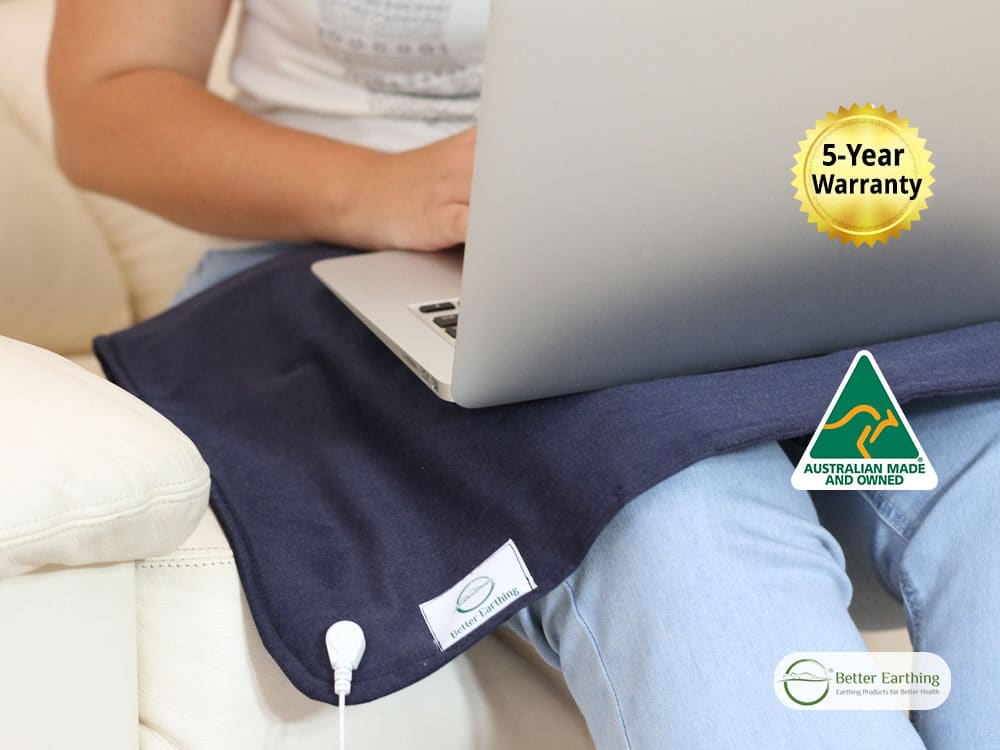Back Pain Relief

Back pain is a common condition which may be caused by bad posture, injury or conditions such as arthritis or osteoporosis. The symptoms can range from mildly uncomfortable to severely debilitating, in some cases making it impossible to live a normal life.
Thankfully, there are plenty of different treatment options for back pain, from over-the-counter painkillers to surgery. There are also many natural remedies that can help to relieve the symptoms of back pain without the need for medication. These include massage, manual therapies, acupuncture, herbal remedies, and earthing. The last of these uses the earth’s natural electrical charge to gently influence the human body. It resets biological rhythms, reduces inflammation, and relieves pain among other health benefits. See more earthing benefits here.
What Back Pain Feels Like
Back pain can vary between a dull, nagging ache and sharp, shooting, or excruciating pain. It can affect any part of the back, although the lower spine is especially common. Back pain may be accompanied by stiffness, muscle spasms, or sciatica.
Back pain can be either acute or chronic. Acute back pain comes on quickly and is short, usually lasting six weeks or less. It is most often caused by muscle strain and will resolve by itself over time.
Back pain that lasts longer than three months is classed as chronic back pain. This is more likely to be caused by an underlying condition such as arthritis or osteoporosis. This type of back pain tends to get worse over time, and ongoing treatment may be necessary to manage its symptoms.
What Causes Back Pain?
One of the most common causes of back pain is muscle strain. This can happen due to lifting something heavy or twisting the back awkwardly. This type of back pain is usually easy to treat and should improve over a few weeks.
A slipped or herniated disc is another common cause of back pain. A disc is a small sac of cartilage filled with a gel-like substance. These lie between your vertebrae and cushion the movements of your spine. Sometimes one of these discs can bulge out, putting pressure on a nerve. This causes shooting pain which can sometimes extend to the leg (sciatica).
Arthritis is a condition that causes inflammation and pain in the joints, including the spine. It is a chronic condition that requires ongoing treatment to manage its symptoms.
Another chronic condition that causes back pain is osteoporosis. In osteoporosis, the bones become brittle and break more easily. This makes painful fractures of the spine more likely and long-term treatment is needed.
Finally, back pain can be caused by physical irregularities such as poor posture or scoliosis. Scoliosis is an unnatural curving of the spine that puts extra pressure on the back and can cause reduced mobility and pain.
Back Pain Medication and Side Effects
Mild to moderate back pain can be treated with over-the-counter medications such as non-steroidal anti-inflammatory drugs (NSAIDs). These include aspirin, ibuprofen, and naproxen and are available either as tablets to take orally, or creams or gels to be applied directly to the painful area.
NSAIDs effectively reduce inflammation and pain. However, they can cause side effects. The most common side effects of NSAIDs are indigestion and gastric bleeding. They should always be taken after food to minimize this risk. NSAIDs are not suitable for people with bleeding disorders, or liver or kidney disease. They can also cause an allergic reaction and should be used with caution in asthmatics.
For more severe back pain, stronger medications such as benzodiazepines may be prescribed. These include drugs such as diazepam which have the effect of relaxing the muscles and relieving spasms. The main side effects of benzodiazepines are drowsiness, dizziness, and confusion. Therefore they should not be taken by people who need to drive or operate machinery. They also carry the risk of dependence.
Opioid painkillers are also an effective treatment for severe back pain. Like benzodiazepines, they can cause drowsiness and confusion. They may also cause side effects such as constipation, nausea, and vomiting. Opioids can become addictive when taken for long periods and ideally should only be prescribed for short-term use.
If you are suffering from arthritis, you may be offered a corticosteroid injection. These work well to reduce inflammation and pain. Possible side effects include bruising, infection, changes in skin colour, and increased blood pressure or blood sugar.
Natural Remedies for Back Pain
Popular natural remedies for back pain include massage, manual therapies such as osteopathy and chiropractic, acupuncture, and herbal medicine.
Massage works by relaxing the muscles and improving circulation which together act to relieve back pain. Osteopathy and chiropractic differ from massage in that they pay more attention to the joints and correct structural imbalances. Whereas osteopathy is a more holistic treatment, looking at the muscles and joints of the whole body, chiropractic focuses solely on the joints and making “adjustments” where needed.
Acupuncture is a therapy which originated over 2500 years ago in China. It uses fine needles placed at specific points on the body to affect the nervous system, reduce inflammation, improve circulation, and relieve pain.
Herbal medicines can be taken internally to reduce inflammation and pain from within or applied externally. Some common herbal remedies for back pain include turmeric, safflower, and capsaicin, which come from chili peppers.
If you decide to try any of these natural remedies for back pain, be sure to consult a properly qualified practitioner and inform your regular physician of your plans.
There are also plenty of simple ways you can relieve back pain at home. Applying a hot or cold compress or taking a warm bath can help. Exercise can also be beneficial. If you suffer from back pain, it is especially important to do exercises that strengthen your core muscles. You should also incorporate some gentle stretches into your routine.
Earthing or Grounding for Back Pain Relief
Another simple thing you can try for back pain is earthing. Also known as grounding, earthing is a way of utilizing the earth’s natural electrical charge to have a positive effect on the body.
It works on the principle that the earth’s surface is rich in free electrons, giving it a subtle negative charge. When you come into conductive contact with the earth, this charge is transferred to your body. In the body, free electrons act like antioxidants and protect cells against damage from free radicals. Some of the many benefits of earthing include reduced inflammation and pain, better sleep, and lower stress levels.
One of the easiest ways to experience earthing or grounding is by walking outdoors, barefoot, bringing the soles of your feet into direct contact with the earth’s surface. Because this is not always practical, you can also use a specially designed product which allows you to earth indoors. This could be a grounding mat, a pad, or a grounding sheet underlay.
Earthing for back pain works by reducing inflammation. Inflammation happens in response to an injury or infection. White blood cells rush to the affected area and trigger a cascade of chemical signals and activity, working to protect the body against foreign pathogens. This all results in the familiar symptoms that we associate with inflammation – redness, heat, swelling, and pain.
This 2010 study showed that earthing reduced the amount of time taken to recover from delayed onset muscle soreness. This is a common condition that can occur following excessive exercise. The study concluded that earthing reduced the levels of certain white blood cells and affected blood chemistry in such a way that acute inflammation was greatly reduced.
Earthing also regulates levels of a hormone called cortisol. Cortisol is one of the hormones involved in the “fight or flight” nervous response. It also has the effect of stopping the inflammatory process. This 2004 research study found that earthing normalized cortisol levels throughout the day, improved sleep, and reduced pain.
You can read more about the benefits of earthing and how earthing works.
Back Pain at Night
Back pain can seriously interfere with your sleep, making it difficult to get comfortable or causing you to wake up during the night in pain. Sleep plays an important role in the body’s ability to rebuild and repair itself, so losing out can mean increased pain levels the following day.
Earthing overnight is one way to reduce your pain symptoms at night time and improve your sleep. This clinical study on the effects of earthing during sleep, published in the Journal of Alternative and Complementary Medicine, found that 91% of its subjects reported improved sleep, while 83% had reduced pain levels.
Earthing overnight is done using an earthing sleep system. This consists of a mattress pad, undersheet, or pillowcase which has been interwoven with conductive fibers. This is grounded to earth in one of two ways. It can be attached via a wire to a conductive earthing rod which is placed in the ground outdoors, or simply earthed through your power outlet.
Back Pain Case Studies
Dr William Amalu is a clinical thermologist and president of the International Academy of Clinical Thermography. He has published a series of case studies highlighting the benefits of earthing for pain.
One 85-year-old male had been suffering from chronic lower back pain, shoulder pain, and stiffness for 4 months. After 2 nights of earthing, he reported a 50% reduction in pain and after 4 weeks had total resolution of pain with only occasional stiffness remaining.
Another male, aged 46 had been suffering from chronic lower back pain for 10 years. After just 30 minutes of earthing, he experienced a 40% reduction in symptoms. After one week of earthing, his pain was reduced by 70%, and by 4 weeks it was reduced by 90%.
A 44-year-old female had been suffering from significant mid-back pain for 9 months. After 4 nights of sleeping on earthed bedding, she reported a 30% reduction in pain. After 4 weeks her pain had further reduced to 80% and after 8 weeks was completely gone with only mild stiffness on awakening in the mornings.
How Much Earthing Do I Need?
Although it can take a few weeks to fully experience all of the benefits of earthing, many positive changes happen within just a few seconds.
After 4 seconds of earthing, your nervous system is calmed and your muscles begin to relax.
30 minutes to two hours of daily earthing provides reduced inflammation and pain, improved circulation, decreased stress levels, and a more positive mood.
Earthing overnight provides all of the above benefits plus falling asleep more easily, waking less during the night, and reduced nighttime pain.
To get started take a look at the indoor earthing products in our shop.
Earthing Research
Oschman J, Chevalier G, Ober, A.C. ‘Biophysics of Earthing (Grounding) the Human Body’ in Rosch P ed. Bioelectromagnetic and Subtle Energy Medicine. Routledge 2010.
Ghaly M, Teplitz D. ‘The biologic effects of grounding the human body during sleep as measured by cortisol levels and subjective reporting of sleep, pain, and stress’ Journal of Alternative and Complementary Medicine 2004;10 (5): 767–776.
Amalu, W. Clinical Earthing Application in 20 Case Studies, unpublished research by the president of the International Academy of Clinical Thermography.





